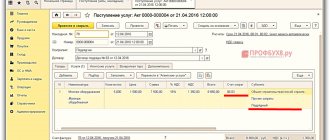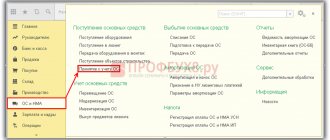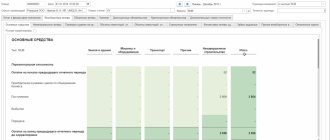Budgetary organizations are institutions financed from budgetary funds. Accounting in such organizations is carried out on the basis of a special chart of accounts for budgetary institutions with their own entries, which was approved by Order No. 174n of the Ministry of Finance of the Russian Federation dated December 16, 2010. In all budgetary institutions, fixed assets, according to Instruction No. 25n, are accounted for in account No. 010100000 - Basic facilities.
Let's consider accounting for fixed assets in budgetary institutions in 2020 and 2021 for beginners.
Signs that an object is classified as fixed assets in budgetary institutions:
- its use in the course of the organization’s activities for management needs, during the performance of work or provision of services;
- The useful life of such an object is over 12 months.
The minimum cost for fixed assets of budgetary organizations has not been established.
Rice. 1. Classification of fixed assets of budgetary organizations.
Group accounting of fixed assets in a budgetary institution can be carried out for objects costing up to 40,000 rubles.
Fixed assets of budgetary institutions also include:
- the tenant's completed capital investments in the properties leased by him;
- investment in perennial plantings.
Why is dismantling necessary?
The need to dismantle a fixed asset may arise as a result of the partial liquidation of an object or become an independent business operation, as a result of which several independent objects are formed that need to be formalized and registered.
Signs of dismantling of a fixed asset:
- the fixed asset was previously accepted for accounting (budget) accounting as one inventory item (inventory unit);
- there is a decision of the Commission on the receipt and disposal of assets operating in the institution (clause 34 of Instruction No. 157n);
- the fixed asset is disassembled (divided) into separate parts, which are taken into account as independent objects of fixed assets or are subject to dismantling and destruction.
The dismantling of a fixed asset must be properly documented and reflected in accounting (budget) and tax accounting if your fixed asset is depreciable.
It is not allowed to carry out measures to dismantle a fixed asset without a documentary basis, that is, until the Commission approves the relevant act.
How to arrange dismantling
When dismantling a fixed asset, it must be excluded from accounting. The basis for the accountant to reflect such a transaction will be the decision of the Commission on the receipt and disposal of assets, documented in the appropriate act depending on the type of fixed asset (clauses 34, 51 of Instruction No. 157n):
- act on the write-off of non-financial assets (except for vehicles) (f. 0504104);
- act on the write-off of soft and household equipment (f. 0504143);
- act on the write-off of excluded objects of the library collection (f. 0504144).
Reflection of depreciation of fixed assets in the accounting of budgetary and autonomous institutions
On a monthly basis, the institution reflects the amount of accrued depreciation as a debit to “cost” accounting accounts. For this we use:
- if depreciation is accrued on fixed assets involved in the capital construction of real estate or the creation of other non-financial assets of the institution - account 0 106 00 000 “Investments in non-financial assets” (according to the corresponding analytical accounts);
- if depreciation of a fixed asset is involved in the formation of the cost of finished products, work, services or is taken into account in distribution costs - account 0 109 00 000 “Costs for the manufacture of finished products, performance of work, services” (according to the corresponding analytical accounts);
- if depreciation of a fixed asset does not participate in the formation of the cost of finished products, works, services and is not taken into account in distribution costs - account 0 401 00 000 “Expenses of the current financial year” (analytical account 0 401 20 271 “Expenses for depreciation of fixed assets and intangible assets” ).
When using account 0 109 00 000, the following analytical accounting accounts are used (depending on the direction of use of fixed assets):
- 0 109 60 271 “Depreciation of fixed assets and intangible assets in the cost of finished products, works, services” - for property used in production of one single type of annual product (performing one type of work, providing a service);
— 0 109 70 271 “Overhead costs for the production of finished products, works, services in terms of depreciation of fixed assets and intangible assets” - for property used in the production of several types of annual products (performance of work, provision of services), depreciation for which is taken into account as part of invoices expenses;
- 0 109 80 271 “General business expenses for the production of finished products, works, services in terms of depreciation of fixed assets and intangible assets” - for property used for the needs of management and maintenance of an institution not directly related to the process of manufacturing products (performing work, providing services ), depreciation for which is not taken into account as part of direct or overhead costs;
- 0 109 90 271 “Distribution costs in terms of depreciation of fixed assets and intangible assets” - for property used in the process of selling goods and promoting them (for example, advertising).
The corresponding account is the corresponding analytical accounts of account 0 104 00 000 “Depreciation”.
Example
The example data is conditional. Through income-generating activities, the institution acquired the following fixed assets:
— administrative building for general purposes with an initial cost of RUB 4,500,000. (accounted for in the analytical account 2 101 12 310);
— building of a workshop for the production of finished products with an initial cost of 1,400,000 rubles. (accounted for in the analytical account 2 101 12 310);
- a building used for the sale and storage of purchased goods with an initial cost of RUB 1,860,000. (accounted for in the analytical account 2 101 12 310);
— computer equipment for management and general economic purposes with an initial cost of 240,000 rubles, related to particularly valuable property (accounted for in the analytical account 2,101,24,310);
— machines and production equipment intended for the production of finished products with an initial cost of 480,000 rubles, related to particularly valuable property (accounted for in the analytical account 2,101,24,310);
— computer equipment used in the production process of finished products, with an initial cost of 67,000 rubles, related to particularly valuable property (accounted for in the analytical account 2,101,24,310);
— commercial equipment with an initial cost of 160,000 rubles, related to other movable property (accounted for in the analytical account 2,101,34,310).
The administrative building, workshop and trade building are included in the 10th depreciation group. According to the Unified Standards of Depreciation Charges, depreciation is charged on them in the amount of:
— administrative building — 1.0%;
— workshop building — 1.7%
- building used in trading activities - 1.2%.
Computer equipment is included in the 2nd depreciation group (useful life from 2 to 3 years inclusive). According to it, the period of use is set at 3 years. Machine tools, production and commercial equipment are included in group 3 (useful life from 3 to 5 years inclusive). According to it, the period of use is set at 5 years.
The amount of depreciation of the administrative building for general purposes will be:
- annual:
RUB 4,500,000 × 1.0% = 45,000 rub.;
- monthly:
45,000 rub. × 1/12 = 3750 rub.
When calculating depreciation, the following entries are made monthly in the institution's accounting records:
Debit 2,109 80,271 Credit 2,104 12,410
– 3750 rub. — depreciation has been accrued for the administrative building for general purposes.
The depreciation amount for the workshop building will be:
- annual:
RUB 1,400,000 × 1.7% = 23,800 rubles;
- monthly:
RUB 23,800 × 1/12 = 1983.33 rub.
When calculating depreciation, the following entries are made monthly in the institution's accounting records:
Debit 2,109 60,271 Credit 2,104 12,410
– 1983.33 rub. — depreciation has been calculated for the workshop building.
The depreciation amount for a building used in trading activities will be:
- annual:
RUB 1,860,000 × 1.2% = 22,320 rubles;
- monthly:
RUB 22,320 × 1/12 = 1860 rub.
When calculating depreciation, the following entries are made monthly in the institution's accounting records:
Debit 2,109 90,271 Credit 2,104 12,410
– 1860 rub. — depreciation has been accrued for a commercial building.
The depreciation rate for computer equipment is:
100%: 3 years = 33.33%.
The annual amount of depreciation charges for management and general business equipment will be equal to:
240,000 rub. × 33.33% = 79,992 rub.
The monthly depreciation amount for it will be:
RUB 79,992 × 1/12 = 6666 rub.
When calculating depreciation, the following entries are made monthly in the institution's accounting records:
Debit 2,109 80,271 Credit 2,104 24,410
– 6666 rub. — depreciation was accrued for management and general business equipment.
The annual amount of depreciation charges for equipment used in the production process of finished products will be equal to:
67,000 rub. × 33.33% = 22,331 rub.
The monthly depreciation amount for it will be:
RUB 22,331 × 1/12 = 1861 rub.
When calculating depreciation, the following entries are made monthly in the institution's accounting records:
Debit 2,109 60,271 Credit 2,104 24,000
– 6666 rub. — depreciation has been accrued on computer equipment used in the production process.
The depreciation rate for machine tools, production and commercial equipment is:
100%: 5 years = 20%.
The annual amount of depreciation for machines and production equipment will be equal to:
480,000 rub. × 20% = 96,000 rub.
The monthly depreciation amount for them will be:
96,000 rub. × 1/12 = 8000 rub.
When calculating depreciation, the following entries are made monthly in the institution's accounting records:
Debit 2,109 60,271 Credit 2,104 24,410
– 8000 rub. — depreciation was accrued on machines and production equipment.
The annual amount of depreciation charges for commercial equipment will be equal to:
160,000 rub. × 20% = 32,000 rub.
The monthly depreciation amount for them will be:
32,000 rub. × 1/12 = 2666.67 rub.
When calculating depreciation, the following entries are made monthly in the institution's accounting records:
Debit 2,109 90,271 Credit 2,104 34,410
– 2666.67 rub. — depreciation has been accrued on commercial equipment.
Based on materials from the reference book “Annual Report of Budgetary and Autonomous Institutions” under general. edited by V. Vereshchaki
What entries should be included in accounting (budget) accounting?
Review correspondence for various types of institutions.
The first step is to write off the fixed asset. Let us remind you that all transactions with fixed assets are recorded at their original (book) cost.
Postings in the budget accounting of a government institution:
| Contents of operation | Debit | Credit | Rationale |
| Write-off of the book value of fixed assets | KDB 1.401.10.172 | KRB 1.101.ХХ.410 | clause 10 of Instruction No. 162n |
| Write-off of accrued depreciation and (or) impairment loss (if any) | KRB 1.104.ХХ.411 KRB 1.114.ХХ.412 | KDB 1.401.10.172 |
Postings in the accounting of a budgetary institution:
| Contents of operation | Debit | Credit | Rationale |
| Write-off of the book value of fixed assets | 0.401.10.172 | 0.101.ХХ.410 | clause 12 of Instruction No. 174n |
| Write-off of accrued depreciation and (or) impairment loss (if any) | 0.104.ХХ.411 0.114.ХХ.412 | 0.401.10.172 |
Postings in the accounting records of an autonomous institution:
| Contents of operation | Debit | Credit | Rationale |
| Write-off of the book value of fixed assets | 0.401.10.172 | 0.101.ХХ.410 | clause 12 of Instruction No. 183n |
| Write-off of accrued depreciation and (or) impairment loss (if any) | 0.104.ХХ.411 0.114.ХХ.412 | 0.401.10.172 |
In the correspondence accounts given in the table, in 24-26 digits of the account number, KOSGU codes are indicated (clause 3 of Instruction No. 183n). However, according to clause 21 of Instruction No. 157n, autonomous institutions in these categories account numbers of the working chart of accounts reflect the analytical code of receipts and disposals of accounting objects. We recommend that you formalize the applicable procedure for generating an account number in your accounting policy.
The second step is recognition (acceptance for accounting) of independent fixed assets formed as a result of dismantling. This operation must be documented with a supporting document (primary accounting document) (clause 34 of Instruction No. 157n). We propose to draw up an act on the acceptance and transfer of non-financial assets (f. 0504101).
The valuation of fixed assets accepted for accounting is carried out at the cost at which they were previously recorded before the merger (creation of a complex of fixed assets). Distribute accrued depreciation and losses from impairment of dismantled fixed assets among the received fixed assets based on their cost.
Postings in the budget accounting of a government institution:
| Contents of operation | Debit | Credit | Rationale |
| Accounting for fixed assets, as well as depreciation and impairment losses | KRB 1.101.ХХ.310 KDB 1.401.10.172 | KDB 1.401.10.172 KRB 1.104.ХХ.411 KRB 1.114.ХХ.412 | Clause 10 of Instruction No. 162n |
Postings in the accounting of a budgetary institution:
| Contents of operation | Debit | Credit | Rationale |
| Accounting for fixed assets, as well as depreciation and impairment losses | 0.101.ХХ.310 0.401.10.172 | 0.401.10.172 0.104.ХХ.411 0.114.ХХ.412 | Clause 12 of Instruction No. 174n |
Postings in the accounting records of an autonomous institution:
| Contents of operation | Debit | Credit | Rationale |
| Accounting for fixed assets, as well as depreciation and impairment losses | 0.101.ХХ.310 0.401.10.172 | 0.401.10.172 0.104.ХХ.411 0.114.ХХ.412 | Clause 12 of Instruction No. 183n |
In the correspondence accounts given in the table in 24 - 26 digits of the account number, KOSGU codes are indicated (clause 3 of Instruction No. 183n).
For fixed assets accepted for accounting, open new inventory cards (f. 0504031 or f. 0504032) (clause 54 of Instruction No. 157n, Guidelines for the use of forms of primary accounting documents and the formation of accounting registers).
Reflection in the accounts of acquisition and receipt of fixed assets
Fixed assets are recorded in accounting registers at their original cost. It includes the costs of purchasing and constructing facilities, consulting services, delivery and other costs required to bring the facility into a state of readiness for operation, taking into account the VAT charged. Accounting in budget accounting accounts is carried out in rubles and kopecks.
Budgetary institutions can, in addition to budget financing, receive income from extra-budgetary sources, including from entrepreneurship, and VAT reimbursement is provided.
Example. The budgetary institution paid for and purchased equipment worth 236,000 rubles from budget funding. (of which 36,000 rubles are VAT) Delivery costs incurred by the transport organization amounted to 11,800 rubles. (VAT – 1800 rub.). The equipment has been put into operation.
Postings:
| Account Dt | Kt account | Wiring Description | Transaction amount | A document base |
| 110631310 | 130231730 | Receiving equipment | 236000,00 | Acceptance and transfer certificate f.No. OS-1 budget. |
| 110631310 | 130222730 | Reflection of equipment delivery costs | 11800,00 | Contract for the provision of transport services |
| 110434310 | 110631410 | Commissioning of equipment | 247800,00 | Inventory card f.No. OS-6 budget. |
Disposal of an inventory item as a result of dismantling in 1C
The disposal of fixed assets as a result of dismantling is documented in the document “Write-off of assets of fixed assets, intangible assets, legal acts” (Section “Assets, intangible assets, legal acts” - command of the navigation panel “Write-off of objects of fixed assets, intangible assets, and legal acts”). When filling out the document on the line “Type of write-off”, you should select the value “Write-off of own fixed assets on the balance sheet (101, 102, 103)”. On the “Fixed Assets, Intangible Assets, Legal Entities” tab, we indicate the inventory item that is subject to dismantling and the reason for write-off. The remaining details will be filled in automatically.
On the “Accounting transaction” tab, to generate transactions in the “Typical transaction” attribute, select the operation “Disassembly of OS objects (401.10.172)”. Account 401.10.172 is automatically indicated as the write-off account. In the “Account” line, indicate the KPS and post the document.
When posting a document in the usual manner, depreciation is calculated for the current month (for objects with a linear depreciation method) and accounting records are generated for writing off the book value and depreciation in correspondence with account 401.10.172.
From the document you can generate an “Act on the write-off of non-financial assets (except vehicles) (form 0504104)” and/or an “Accounting certificate (form 0504833)”.






